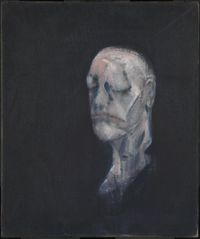"'Mad, bad and dangerous to know' as he was, Francis Bacon became a father figure for me and the central influence on my life."
Retrospectives are designed to capture an artist's full potential, total creation, and whole being in a defined space.
Memoirs function similarly—a full measure of an artist between two covers. Francis Bacon In Your Blood differs. It is not the story of Francis Bacon so much as it's the story of Bacon's influence on another man, Michael Peppiatt (born October 9, 1941), a young journalist who became Bacon's closest friend and biographer. Through this distance, we see Bacon clearly.
Peppiatt met Bacon in 1963 when the former was a young Cambridge graduate looking for an interview. Bacon was fifty-three and established as an artist. Peppiatt was immediately taken by the presence of this grand, charming, and erudite man.
I had found not only a more exciting mode of life but an older man whom I admired increasingly for his freedom, vitality, and artistic brilliance. What I needed, way beyond the flattery and luxury that I lapped up as a threadbare student, was a father figure. And in Francis, I found him.
 Francis Bacon and Michael Peppiatt.
Francis Bacon and Michael Peppiatt. 'I'm only trying to deform into truth,' Francis says. 'After all, photography has done so much, so how are you to make a portrait nowadays unless you can bring what's called the facts of someone's appearance more directly and more violently back on to the nervous system? You have to deform appearance into image. There it is. I wouldn't let any of this out if I didn't have to live.'
Bacon's need to live, to reach beyond photographs, and to use the deformed form to convey emotion is his distinction, his legacy. His portraits deliver primal, unsheathed honesty at a corpuscular level. A mesmerizing, metastasized pain dripped into our blood through the eyes.
 Study for Portrait II (after the Life Mask of William Blake)" by Francis Bacon, 1955. Learn more.
Study for Portrait II (after the Life Mask of William Blake)" by Francis Bacon, 1955. Learn more."We get caught up again in a round of bars like mice on a treadmill without stopping until exhaustion sets in, and we part, grey with fatigue and barely able to stand, at dawn." Peppiatt brings us to Bacon's Soho haunts, his relationships with artists like Lucian Freud, and his heavily social and alcohol-fueled nights. Bacon was driven by relentless energy, an impetuous cycle through manic energy.
What is also very attractive is the feeling of boundless energy coming off him, radiating through his gestures and the relentless way he keeps returning to a subject until he feels it can't be analyzed and refined further, even if he's only had a couple of hours sleep and has been doing the bars all afternoon."
In Bacon's own words:
What I always hope for—this sounds terribly pretentious, perhaps one always sounds pretentious when one's talking about oneself—is this one absolutely perfect image which will cancel all the others out. Make this thing like an idol which would blink out all kinds of other beautiful images.
While often labeled "eccentric," Bacon, as seen by Peppiatt, was deeply connected to human motivations and needs. The suicide of his long-time lover, for example, precipitated one of Bacon's most fragile and artistic periods. Bacon circled a truthful expression of all humans' pain on canvas and in life.
Art is more than the final product; it is the formation of that product by the artist as it has existed.
 "Study for a Portrait" by Francis Bacon, 1952. Bacon's distortion of an unnamed man in the suit is also entitled "Businessman." Learn more.
"Study for a Portrait" by Francis Bacon, 1952. Bacon's distortion of an unnamed man in the suit is also entitled "Businessman." Learn more.About myself, my thoughts and feelings are what are called moeurs of my times. But then I think I go deeper than my times. That may be a profoundly vain thing to say, but I often feel in my work that I'm closer to the ancient world. I think you can convey all sorts of things about yourself, or about anything really, in painting. I think it's more difficult in words, even though one never tires of talking about oneself, n'est-ce pas?
While Peppiatt captures these intimacies of Bacon, one wonders if it isn't Peppiatt in the first place who solicited them. It inspired them through friendship and witness.
 Inspired by Bacon's portraiture study, I call this "Businessman contemplating Bacon contemplating van Gogh." The canvas is "Study for a Portrait of van Gogh IV," painted by Bacon in 1957. Learn more.
Inspired by Bacon's portraiture study, I call this "Businessman contemplating Bacon contemplating van Gogh." The canvas is "Study for a Portrait of van Gogh IV," painted by Bacon in 1957. Learn more.Human self-awareness brings us a question of what it means to tell another's story, or as we see from Mary Oliver on Emerson or Toni Morrison on Martin Luther King, Jr. to tell of another's greatness. Being seen and having our story told, having another being say, "You exist." We need that. We need a Boswell or a Peppiatt to document our being.
In the warm, complicated affirmation from Bacon, Peppiatt found his expression and exposure. In return, he exposed Bacon—the natural, intimate, human Francis Bacon—to the world.
Bacon sought to prick our unconscious, to prime nerves saturated through overexposure to images. To engender knowledge through emotions. Susan Sontag's Regarding the Pain of Others looks more closely at this saturation of empathy. I also recommend the deeply enriching The Letters of Vincent van Gogh, a book—and an artist—that influenced Bacon profoundly. "I reread them all the time," Bacon wrote of The Letters.

